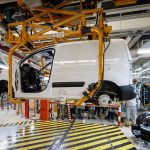The role of technological innovation in energy transition in electricity generation
The generation, distribution, and usage of electrical power are undergoing a change not seen for decades. As the world adapts to climate change and geopolitical uncertainties, innovative technologies are spurring a massive change in the entire energy ecosystem with companies like EDP – Energias de Portugal leading the way.
Text: Chris Graeme. Photo: Renata Schiavon
One of the world’s major electrical energy producers, EDP – Energias de Portugal, in particular its renewables arm EDPR, has shown extraordinary growth over the past few years, currently operating in 28 international markets including the UK, US, Canada, Chile, France, Germany, Brazil, and Hungary to name a few.
Vera Pinto Pereira, Executive Board Member at EDP Group, CEO EDP Commercial, and President of the EDP Foundation, gave an elucidative talk at the most recent Fireside Chat – ‘Conversations on Change with Innovative Companies and Inspiring People’ moderated by Maria João Ricou, Senior Partner at Cuatrecasas Portugal – which hosted the event held on June 7.
Ambitious targets
Vera says that the energy sector is undergoing a profound transformation nothing short of a revolution.
This has been spurred by global targets defined by the European Commission to reduce EU final energy consumption by 11.7% by 2030, and more specifically Portugal’s target to achieve 47% of its energy requirements from renewable energy in gross final energy consumption, and a target of 20% renewable energy in transport by the same date.
“We have to triple our renewable energy capacity by 2030, and this challenge is of such a magnitude that it raises a number of questions and challenges in which electrical energy producers will have an important role to play across the board,” says Vera Pinto Pereira.
Today, as part of its mission to meet the targets to cut greenhouse gas emissions, EDP has around 70% of the technology required to do so already invented and developed.
In 2022, EDP raised its ambition by committing to reach net zero greenhouse emissions across the value chain by 2040, with ambitious mid-term targets by 2030 (from a baseline year set for 2020).
The overall goal is to reduce 90% of scope 1, 2 and 3 emissions by 2040 vs. 2020 with near term targets by 2030. Scope 1 are those direct emissions that are owned or controlled by the company, whereas scope 2 and 3 indirect emissions are a consequence of the activities of the company but occur from sources not owned or controlled by it.
There are around 10 new technologies that can support energy transition, some of which are still in development and not yet scalable or ready for commercialisation. EDP still has an additional 30% of its technology to be developed.
And there are value chain limitations to significantly scaling and accelerating renewable energy technologies. In terms of value chain, it is important to mention that notwithstanding targets set by both the United States and the European Union for greater independence and autonomy from third party fossil fuel suppliers, like Russia; today in Europe around 65-70% of the necessary components for energy transition come from China.
Ironically, China is the world’s largest coal user but also the biggest producer of renewable energy, with the country last year on track to build as much new solar capacity as the total installed capacity in the United States, according to the Centre for Research on Energy and Clean Air.
China is the world’s top supplier of renewable energy technologies and will have more than 80% of the world’s solar manufacturing capacity through 2026, according to forecasts from consultancy Wood Mackenzie.
The country dominates the solar panel supply chain from end to end, exceeding 80% of manufacturing capacity in every stage, according to Rystad Energy. It can make 1,000 GW of solar modules each year, more than twice global demand.
Its massive production is driving solar component prices to all-time lows, according to price reporting agency OPIS.
While falling prices will accelerate the energy transition, analysts say, the US and other countries trying to expand domestic production worry their manufacturers won’t be able to compete.
“We want to achieve the targets of autonomy and independence, but there is still some way to go in terms of innovation and greater geopolitical balance, and not just technological innovation, but industrial and business, or innovation at various levels”, says Vera Pinto Pereira.
In fact, that the EU imports almost 60% of its energy shows that real EU strategic autonomy in energy is far from achieved. The current energy crisis poses a risk to all four EU energy policy objectives. Crisis in the energy market has caused public and private debt and inflation, which risks destabilising the European energy market. While diversifying gas imports away from Russia reduces dependency on one big supplier, and reliance on several other third countries imply new supply risks.
The problem of licensing
The other big challenge highlighted by Vera Pinto Pereira is licensing, and the huge mountain of bureaucracy and complexity behind it to produce gigawatts of renewable energy, which is substantially holding up the development required for the road that should be taken to reach EU and global targets.
The permit processes for renewable energy projects can be complex and time-consuming. Obtaining the necessary approvals from multiple regulatory authorities and addressing environmental and social impact assessments often prolong project development timelines. Streamlining and expediting permitting procedures, while ensuring thorough assessments, would help reduce delays and enhance project bankability.
A slow-moving permitting process often reduces the impact of supportive policies, regulations and financial incentives designed to speed up the energy transition.
Between 2018 and 2022, for example, projects seeking to be connected to the power grid in the United States spent on average, four years in the interconnection queue waiting for approval.
The story is similar in other parts of the world, including the EU. Often, improving this situation would not necessarily require new laws or regulations, but rather a streamlined process and more staff processing the requests. This begs the question; can regulators and policymakers reduce the time needed to obtain the necessary licences by 50% in 2024?
Vera Pinto Pereira says EDP has 3 Terawatts of green energy projects awaiting licences, but operations are at a standstill because they are paralysed in the gateway of bureaucracy.
“I believe that AI could have an important role in simplifying and accelerating these processes”.
Problems of regulation
Vera Pinto Pereira says that another stumbling block to getting green energy projects off the ground are the significant policy and regulatory challenges that hinder their development and implementation.
The successful deployment of renewable energy projects requires a supportive policy and regulatory framework. Policies and regulations that provide clarity, stability, and incentives can create an enabling environment for investment and project development. However, several challenges persist, including inconsistent policies
Inconsistent or constantly changing policies can create uncertainty for investors, making it difficult to plan and secure financing. Clear and stable policies that provide long-term visibility and align with renewable energy targets are crucial for attracting investments and fostering project development.
“In Europe we have a set of regulations that need to be more uniform. We’ve had years of conflicts which have brought instability to the energy sector with different reactions from various countries over regulation that have not helped, and we need greater uniformity and stability regarding regulation because of the investment that energy transition requires, and it needs to be a regulation that can cover several new realities.”
A huge injection of renewable energy into the system implies an equally large amount of volatility because these new energies are volatile by definition.
“This means that we have to have flexible management systems and a system of regulation that is completely different, which implies that regulation should also evolve at the same pace as the technological innovations in electrical systems. This goes too for flexibility in storage”, she adds.
Talent
One thing that is certain is that energy transition will create hundreds of thousands of new jobs for people with different qualifications.
Employment opportunities are a key consideration in planning for a low-carbon economy. Many governments have prioritised renewable energy development, firstly to reduce emissions and meet international climate goals, but also in pursuit of broader socio-economic benefits.
As the energy transition accelerates, job gains and losses can be expected as economic structures evolve. Jobs represent a tangible benefit that gives people a stake in this transformation, and therefore promises to raise its political acceptance.
Renewable energy employment worldwide has continued to grow since the International Renewable Energy Agency (IRENA) initiated its annual review; the first edition of the Review estimated 7.3 million jobs in 2012. The tenth edition of IRENA’s series, ‘Renewable energy and jobs: Annual review 2023’, produced in collaboration with the International Labour Organization (ILO), estimated at least 13.7 million jobs in renewable energy employment globally.
According to IRENA, worldwide employment in renewable energy in 2022 stood at 13.7 million (4.9M in solar, 1.4M in wind, 2.5M in hydropower, and 2.5 in biofuels.
“This is a tremendous opportunity for Portugal as a country with over 300 days of sun per annum to be in the front line of energy transition and we have the capacity to attract and develop talent and will require a huge effort to access labour, and once again AI will have an important role”.
Reducing emissions by electrifying heat
Vera Pinto Pereira says that 40% of greenhouse gas emissions can only be avoided not through the injection of more renewable energies into the system, but rather through changes in behaviour by the final consumer.
The mounting research on consumer behaviour and climate change is gradually improving our understanding of effective ways to mobilise consumers to mitigate climate change.
The relationship between consumer behaviour and climate change is complex and most consumers are not always capable of determining which behaviour changes are worth doing.
The most important implication of the reviewed research is that most focus should be on making climate friendly behaviour the easy behaviour, in terms of securing a correct reflection of carbon footprint in prices, climate friendly products that compare favourably to unfriendly alternatives, and carbon labelling.
In fact, 50% of this challenge is in the hands of the end consumer such as us, but also services, industry, and the entire company network.
“It is fundamental that this is done through the electrification of consumption, including mobility, air conditioning and heating.
“If we electrified heat pumps this would save the equivalent of the gas emissions produced by all the cars on the road in Europe”, says Vera Pinto Pereira.
So, electrifying the heat component whether in our own homes, offices, industrial premises is vital, but at the same time is one of the most difficult challenges to overcome.
“This can be achieved through decentralised solar power supply and in Portugal alone over 150,000 families already using solar panels on their roofs generating their own power, but obviously this requires a lot more technological effort so that the business case model is more attractive for final clients and companies, particularly large ones that can install a facility producing enough energy to supply the surrounding community.”
EDP, in partnership with other global leading energy companies, has been working with startups through the Free Electrons Programme, the largest global innovation programme in the energy sector.
As a global open innovation programme, Free Electrons will focus on the possibilities of developing projects and business between startups and industry players with the aim of finding solutions that can have an impact on the energy transition, in areas such as renewable energy, smart grids, energy management, sustainable mobility, energy storage, flexibility, green hydrogen or decarbonisation.
So far, the company has invested around €40 million in pilot projects, investments and businesses with startups that have participated in the programme. The 8th edition EDP welcomed the startups between 27-30 May this year at a bootcamp in Madrid where EDP selected 29 startups from 15 nationalities.
The selected companies operate in six key energy transition sectors and work towards EDP’s strategic areas of innovation, including decarbonisation, distributed energy resources, energy storage and flexibility, green hydrogen, networks and renewable energy sources.
“We’ve done quite a lot of work at EDP both in terms of consumers and industry, much of it through our innovation arm which has had an important role in the electrification of heat in partnership with the ‘Free Electrons’ programme’ where startups work alongside companies like EDP to deliver cutting edge solutions and co-create the future of energy. The programme focuses on working together to pilot projects, commercially deploy products, facilitate investment opportunities, learning and development”.
“However, having different options, whether geothermal power stations or floating offshore wind platforms is key in a market that is going through such a profound transformation and at such a pace that it is difficult to see which of these innovative technologies will win out a few years down the line”, concludes Vera Pinto Pereira, CEO EDP Commercial.










